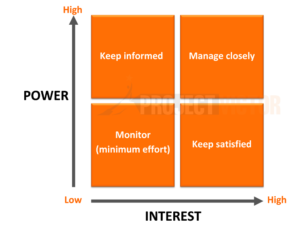Stakeholder analysis involves using qualitative and quantitative data to analyse which stakeholders’ interests should be considered throughout the project. Those with the most influence will have the most impact. During stakeholder analysis, you’ll want to identify the influences stakeholders have on your project and understand their expectations, needs, and demands. From there, you’ll derive more specifics regarding project goals and deliverables. According to the PMBOK Guide, three steps are involved in stakeholder analysis:
Identifying potential stakeholders
Analysing potential impact
Assessing how stakeholders are likely to react in certain situations.
Identifying potential stakeholders
 It is important the project manager identifies all project stakeholders and specifically those that will have a potentially large impact and influence on their projects. The output of this identification process is the stakeholder register, where the project manager identifies and lists all stakeholders on the project. Keep in mind stakeholders may come from various areas or functional departments in the organization or they may include external influencers such as customers, suppliers, sub-contractors, or any other party that may potentially be affected by the deliverables in your project. The PMBOK identifies multiple classification models used for stakeholder analysis:
It is important the project manager identifies all project stakeholders and specifically those that will have a potentially large impact and influence on their projects. The output of this identification process is the stakeholder register, where the project manager identifies and lists all stakeholders on the project. Keep in mind stakeholders may come from various areas or functional departments in the organization or they may include external influencers such as customers, suppliers, sub-contractors, or any other party that may potentially be affected by the deliverables in your project. The PMBOK identifies multiple classification models used for stakeholder analysis:
- Power/Interest Grid: grouping stakeholders based on their level of authority (power) and level of concern (interest).
- Power/Influence Grid: grouping stakeholders based on their level of authority (power) and their active involvement (influence).
- Influence/Impact Grid: grouping stakeholders based on their active involvement in the project and their ability to effect changes to project planning and execution (impact).
- Salience Model: describing classes of stakeholders based on their power (ability to impose their will), urgency (need for immediate attention), and legitimacy (their involvement is appropriate).
Analysing potential impact
 While the project manager seeks to identify potentially all stakeholders on the project, he or she may not need to manage all closely. By analysing each stakeholder identified in the stakeholder register and by determining the potential influence that stakeholder may have on the project, a project manager may then devise strategies to manage those stakeholders.
While the project manager seeks to identify potentially all stakeholders on the project, he or she may not need to manage all closely. By analysing each stakeholder identified in the stakeholder register and by determining the potential influence that stakeholder may have on the project, a project manager may then devise strategies to manage those stakeholders.
For example, if the project manager identifies the Chief Financial Officer of the organization as a potentially influential stakeholder on the project, the project manager may then work closely and intricately with the Chief Financial Officer to better understand their needs and expectations on the project. The project manager may invite him/her to key project meetings and may include them in all project progress reports and steering committees.
Assessing how stakeholders are likely to react in certain situations
Identifying and understanding the level of influence and power that certain stakeholders have on a project is only the beginning. The project manager may interview other stakeholders to better understand key stakeholder expectations. The project manager may ask questions about their involvement in past projects and the roles and decisions taken in certain situations. Such information can be obtained by meeting and discussions with the stakeholders themselves or through discussions with their colleagues or people they’ve worked with. By learning about key stakeholder influences, the project manager is better able to address their needs and expectations and is also better able to devise strategies to deal with any type of expected behaviour.
